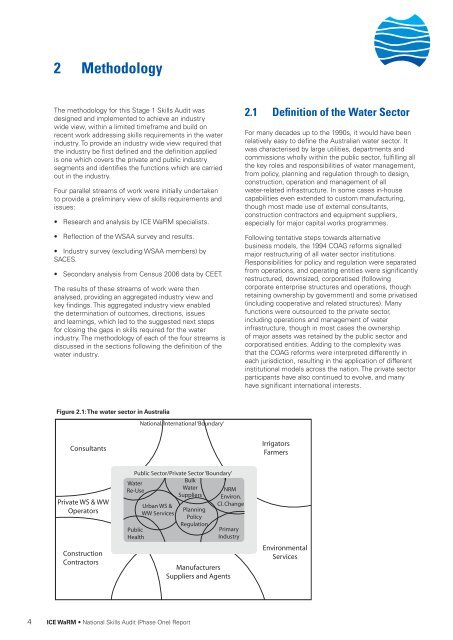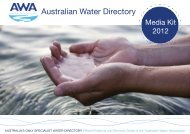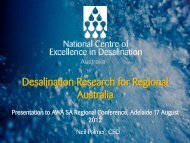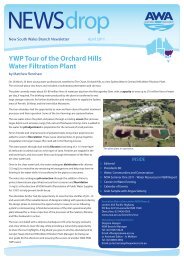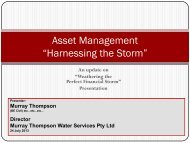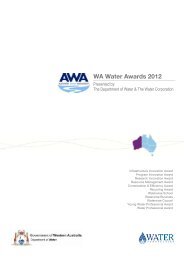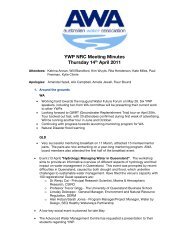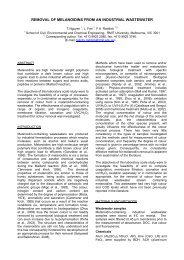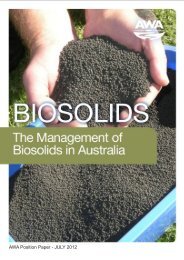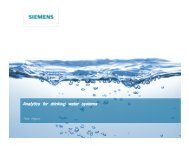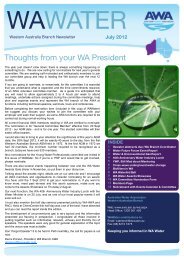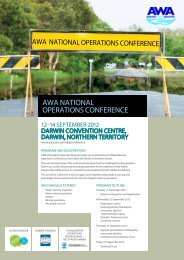National Water Skills Audit - Australian Water Association
National Water Skills Audit - Australian Water Association
National Water Skills Audit - Australian Water Association
- No tags were found...
You also want an ePaper? Increase the reach of your titles
YUMPU automatically turns print PDFs into web optimized ePapers that Google loves.
2 MethodologyThe methodology for this Stage 1 <strong>Skills</strong> <strong>Audit</strong> wasdesigned and implemented to achieve an industrywide view, within a limited timeframe and build onrecent work addressing skills requirements in the waterindustry. To provide an industry wide view required thatthe industry be first defined and the definition appliedis one which covers the private and public industrysegments and identifies the functions which are carriedout in the industry.Four parallel streams of work were initially undertakento provide a preliminary view of skills requirements andissues:• Research and analysis by ICE WaRM specialists.• Reflection of the WSAA survey and results.• Industry survey (excluding WSAA members) bySACES.• Secondary analysis from Census 2006 data by CEET.The results of these streams of work were thenanalysed, providing an aggregated industry view andkey findings. This aggregated industry view enabledthe determination of outcomes, directions, issuesand learnings, which led to the suggested next stepsfor closing the gaps in skills required for the waterindustry. The methodology of each of the four streams isdiscussed in the sections following the definition of thewater industry.2.1 Definition of the <strong>Water</strong> SectorFor many decades up to the 1990s, it would have beenrelatively easy to define the <strong>Australian</strong> water sector. Itwas characterised by large utilities, departments andcommissions wholly within the public sector, fulfilling allthe key roles and responsibilities of water management,from policy, planning and regulation through to design,construction, operation and management of allwater-related infrastructure. In some cases in-housecapabilities even extended to custom manufacturing,though most made use of external consultants,construction contractors and equipment suppliers,especially for major capital works programmes.Following tentative steps towards alternativebusiness models, the 1994 COAG reforms signalledmajor restructuring of all water sector institutions.Responsibilities for policy and regulation were separatedfrom operations, and operating entities were significantlyrestructured, downsized, corporatised (followingcorporate enterprise structures and operations, thoughretaining ownership by government) and some privatised(including cooperative and related structures). Manyfunctions were outsourced to the private sector,including operations and management of waterinfrastructure, though in most cases the ownershipof major assets was retained by the public sector andcorporatised entities. Adding to the complexity wasthat the COAG reforms were interpreted differently ineach jurisdiction, resulting in the application of differentinstitutional models across the nation. The private sectorparticipants have also continued to evolve, and manyhave significant international interests.Figure 2.1: The water sector in Australia<strong>National</strong>/International ‘Boundary’ConsultantsIrrigatorsFarmersPrivate WS & WWOperatorsConstructionContractorsPublic Sector/Private Sector ‘Boundary’Bulk<strong>Water</strong>Suppliers<strong>Water</strong>Re-UsePublicHealthUrban WS &WW ServicesPlanningPolicyRegulationNRMEnviron.Cl. ChangePrimaryIndustryManufacturersSuppliers and AgentsEnvironmentalServicesICE WaRM • <strong>National</strong> <strong>Skills</strong> <strong>Audit</strong> (Phase One) Report


